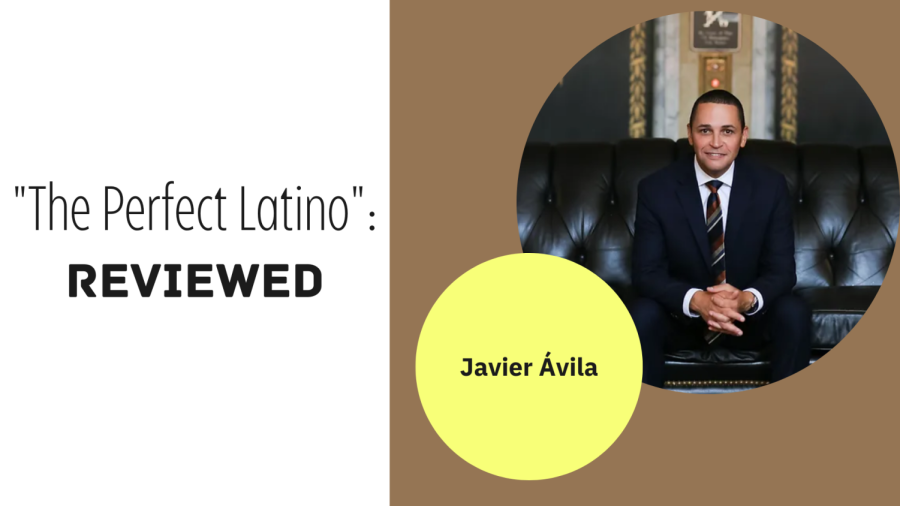The Perfect Latino: A Review of Javier Ávila’s Performance
Javier Ávila performed his show, The Perfect Latino, at PC on September 19th. Design created by Madison Crumpton.
October 5, 2022
The story of one man’s journey of self-discovery as he never felt “Puertorican” or “white” enough is one of the main themes of Javier Ávila’s “The Perfect Latino.”
Performed at Edmunds Hall on September 19th, Ávila shared snippets of his life growing up in Puerto Rico and America, sharing how this internal racial battle in two different societies affected his life, literature, and teaching career.
More in depth, he discusses this battle within his own students during his time as a professor over the years and how his adolescence has helped him be a better person both in his personal and professional life.
Throughout his performance, Ávila calls himself the “white-tino” and he begins by explaining a prime example of this lifestyle through his own family. Currently, Javier has a heart here in the United States with his loved ones, but he also has a heart out to his other relatives and friends down in Puerto Rico, who are recently recovering from a hurricane.
For many of us across the country, Puerto Rico is much of an afterthought and isn’t spoken about daily in our day-to-day conversations since it is merely an article skimmed through on the internet.
However, for people like Javier, the reality of the situation he faces daily could be the fact that for those he left behind, they may be without water and power for a while because of some unseen circumstances he can’t control.
Ávila goes on to explain how other people feel this same type of emotion known as “mixed-belonging”, something that impacts interracial couples. I found this to be an interesting comparison as I did not realize that creating a mixed-race family specifically meant that there was now a sense of not belonging or being able to fit in with your spouse’s family.
While not “fitting in” can be felt by those in same-race marriages, for interracial couples, this aspires to a whole another level. Race creates a social barrier no matter how emotionally attached or connected you are to your spouse’s family. Personally, I had never thought of the reality of longing to belong with your spouse’s family, simply in terms of race.
One thing that I really admired about Javier’s performance was him explaining a situation in which he had scars from a heart surgery he experienced growing up. In elementary school, another kid saw them and called them ugly.
From then on up until adulthood, Javier covered his chest scars frequently. He differentiated that he was never embarrassed by his scar, but he was fearful of being known as the kid with the “disgusting scar,” since he used it as a metaphor for colorism or even racism.
According to Ávila, it isn’t the idea of being judged by color or race, but it is mainly the fact that your color or race is all that someone sees or knows you for. Furthermore, he states that you’ll always be known as one, visual identifier rather than every other individual aspect that you have to offer as a person.
I found this rather intriguing because I’ve never stopped to think about how many people I recognize and remember based on a single visual factor rather than any other aspect I know about them. It’s amazing how my brain has naturally been taught to remember people based on what I see on our first encounter, and not necessarily the ones after.
From a larger perspective, Javier shared many examples of his own educational life and how the Latino community has often been overlooked. For example, he said that 20% of his school’s population was of Latino descent. In comparison, only one percent of the staff were Latino, the equivalent of three Hispanic teachers.
He feels that it is a school’s duty to reflect on whom they are teaching both in class and on the staff. He also noted how a company he worked for once claimed to be “diverse,” but after doing his own research, he noted that there was no diversity among the higher-ups, who were all older white males.
In order to see how diverse a company is, Javier says the best way is to take a look at the most high-ranking positions that the company offers such as the board of directors, trustees, and presidents. If these positions do not reflect the diversity publicized, then the company is not truly diverse. He also explained how both of these examples are real-life scenarios of the lack of diversity and how it doesn’t live in the low barracks.
Another honorable mention of points that Javier made was the idea of assimilation vs. cultural preservation. In terms of “fitting in,” it doesn’t mean trying to match others around you or trying to be more like them.
In fact, you should be able to fit in with those around you as your own person, with your own culture intact. Hence, no one should have to assimilate into someone else’s culture, but instead share their own culture with others. We stand in unison, not as the same, but as unique and different individuals.
The most notable takeaway for me was when Javier told us a story about his son. The context was that his son was playing with another little boy and told everyone, including both sets of parents, that they were brothers. The boys giggled together since not only were they about the same age and height, but no one would be able to tell the overall difference between them, and that they would call themselves twins as a result.
The little boy that they had met during the story was black. Javier’s son is a “white-tino.” As a child, he didn’t see any color or hue at all. He made a connection with the other little boy and to him, that was worth the title of “brother.”
What stood out to me from this story was that Javier is indirectly saying that hate, colorism, and racism is all learned. I wrote down this quote from him specifically where he said the following: “You must see and must accept that we are all brothers and sisters-everything else is in the mind.”
After the performance, Javier took the time to let everyone ask him questions, gave out free autographed poetry books to students, and conversed with viewers in attendance.
Overall, Javier’s one-man show was entertaining and he found a compelling way to share his perspective on the idea of a “Perfect Latino” and what it truly means to be comfortable in your skin. It is also the perfect example of how to successfully honor Hispanic Heritage Month at Presbyterian College and across our country. The show was easily relatable for everyone, comedic, and taught us something new.





